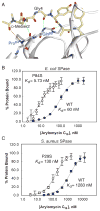Broad-spectrum antibiotic activity of the arylomycin natural products is masked by natural target mutations
- PMID: 21095572
- PMCID: PMC3003444
- DOI: 10.1016/j.chembiol.2010.09.009
Broad-spectrum antibiotic activity of the arylomycin natural products is masked by natural target mutations
Abstract
Novel classes of broad-spectrum antibiotics are needed to treat multidrug-resistant pathogens. The arylomycin class of natural products inhibits a promising antimicrobial target, type I signal peptidase (SPase), but upon initial characterization appeared to lack whole-cell activity against most pathogens. Here, we show that Staphylococcus epidermidis, which is sensitive to the arylomycins, evolves resistance via mutations in SPase and that analogous mutations are responsible for the natural resistance of Staphylococcus aureus, Escherichia coli, and Pseudomonas aeruginosa. We identify diverse bacteria lacking these mutations and demonstrate that most are sensitive to the arylomycins. The results illustrate that the arylomycins have a broad-spectrum of activity and are viable candidates for development into therapeutics. The results also raise the possibility that naturally occurring resistance may have masked other natural product scaffolds that might be developed into therapeutics.
Copyright © 2010 Elsevier Ltd. All rights reserved.
Figures




Similar articles
-
Initial efforts toward the optimization of arylomycins for antibiotic activity.J Med Chem. 2011 Jul 28;54(14):4954-63. doi: 10.1021/jm1016126. Epub 2011 Jun 28. J Med Chem. 2011. PMID: 21630667 Free PMC article.
-
In vitro activities of arylomycin natural-product antibiotics against Staphylococcus epidermidis and other coagulase-negative staphylococci.Antimicrob Agents Chemother. 2011 Mar;55(3):1130-4. doi: 10.1128/AAC.01459-10. Epub 2010 Dec 28. Antimicrob Agents Chemother. 2011. PMID: 21189343 Free PMC article.
-
Type I signal peptidase and protein secretion in Staphylococcus aureus.J Bacteriol. 2012 May;194(10):2677-86. doi: 10.1128/JB.00064-12. Epub 2012 Mar 23. J Bacteriol. 2012. PMID: 22447899 Free PMC article.
-
[Novel inhibitors against the bacterial signal peptidase I].Yao Xue Xue Bao. 2012 Dec;47(12):1561-6. Yao Xue Xue Bao. 2012. PMID: 23460958 Review. Chinese.
-
Bacterial type I signal peptidase inhibitors - Optimized hits from nature.Eur J Med Chem. 2022 Aug 5;238:114490. doi: 10.1016/j.ejmech.2022.114490. Epub 2022 May 26. Eur J Med Chem. 2022. PMID: 35660251 Review.
Cited by
-
Antibacterial Activity of Endophytic Actinomycetes Isolated from the Medicinal Plant Vochysia divergens (Pantanal, Brazil).Front Microbiol. 2017 Sep 6;8:1642. doi: 10.3389/fmicb.2017.01642. eCollection 2017. Front Microbiol. 2017. PMID: 28932210 Free PMC article.
-
Initial efforts toward the optimization of arylomycins for antibiotic activity.J Med Chem. 2011 Jul 28;54(14):4954-63. doi: 10.1021/jm1016126. Epub 2011 Jun 28. J Med Chem. 2011. PMID: 21630667 Free PMC article.
-
Type I signal peptidase and protein secretion in Staphylococcus epidermidis.J Bacteriol. 2011 Jan;193(2):340-8. doi: 10.1128/JB.01052-10. Epub 2010 Nov 12. J Bacteriol. 2011. PMID: 21075926 Free PMC article.
-
Signal peptidase I: cleaving the way to mature proteins.Protein Sci. 2012 Jan;21(1):13-25. doi: 10.1002/pro.757. Epub 2011 Nov 22. Protein Sci. 2012. PMID: 22031009 Free PMC article. Review.
-
Not just an antibiotic target: Exploring the role of type I signal peptidase in bacterial virulence.Bioorg Med Chem. 2016 Dec 15;24(24):6370-6378. doi: 10.1016/j.bmc.2016.09.048. Epub 2016 Sep 21. Bioorg Med Chem. 2016. PMID: 27769673 Free PMC article.
References
-
- Baltz RH. Marcel Faber Roundtable: is our antibiotic pipeline unproductive because of starvation, constipation or lack of inspiration? J Ind Microbiol Biotechnol. 2006;33:507–513. - PubMed
-
- Bumann D. Has nature already identified all useful antibacterial targets? Curr Opin Microbiol. 2008;11:387–392. - PubMed
Publication types
MeSH terms
Substances
Grants and funding
LinkOut - more resources
Full Text Sources
Other Literature Sources
Medical
Molecular Biology Databases

